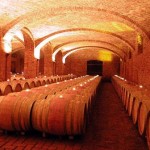A vineyard in Piemonte
Photo/submitted
By Victor Block
The platter was covered with what resembled small piles of leaves from a fall lawn raking. The brown, green and black heaps hardly invited sniffing, much less tasting. Yet sniff and taste I did.
Little did I know, before this introduction to “cheese wrapping,” that a tradition in one corner of Italy is aging cheeses by encasing them in leaves. Nor that there are “cheese hunters” who to seek the best leaves in which to wrap cheeses, and know the amount of time each variety should be aged to bring out its best flavor.
The opportunity to learn about this unusual profession is one attraction of a visit to the Piedmont (Piemonte) province in northwestern Italy. Others include its lovely landscape of rolling hills blanketed by vineyards, and tiny towns that grew up around stone castles in medieval times. Adding to the appeal are an enticing history, and the fact that while Piemontese food and wine are not as well known as world-famous cuisines like that of France, they should be.
Piemonte derives its name from the phrase “ai piedi del monte” (at the foot of the mountains), and the towering peaks of the Swiss and French Alps are visible in the area. A perfect home base for traveling throughout the region is Alba, “the town of 100 towers.” That claim dates back to the 12th and 13th centuries, when noble families competed to build ever-taller fortified towers to both provide protection and demonstrate their wealth. Only four of the original structures still overlook the town, but the name has stuck.
Outside of Alba, roads wind through tiny towns of stone buildings that line narrow cobblestone streets. Many hilltops are capped by the massive walls and turrets of an ancient castle.
Each town has own unique appeals. Serralunga d’Alba is one of 11 villages where Barolo wine may be produced. It, and Barbaresco, are Italy’s most prestigious red wines.
The town of Grinzane Cavour, and 12th century castle of the same name, have a strong connection with viniculture. Among exhibits there is the Regional Piemontese Wine Cellar, which offers tastings of the area’s vintages. Also intriguing is the Masks Room, whose soaring ceiling is painted with portraits of fantasy monsters and creatures that range in countenance from droll to macabre.
Napoleon Bonaparte called Cherasco “le plus beau coin d’Italie” (“the most beautiful corner of Italy”) because of its star-shaped Roman bastion and medieval architecture. The town’s elegant porticoed arcades protect pedestrians from sun and rain. Among the sumptuous palaces is the Palazzo Salmatoris, where the ruling Savoy family spent many a summer holiday. A graceful “Triumphal Arch” was donated by a citizen to give thanks that the plague which wracked the region in 1630 spared the citizens of Cherasco.
Anyone who travels to Italy’s Piedmont region is sure to leave with an appreciation of the importance of both wine and food in the lives of its people, and probably with a few extra pounds as well. Cheese and white truffles hold a place of honor on many a dining table.
Cheese-makers flourished there since the first century A.D. Many farmers continue to follow traditional family recipes, which often call for a mixture of milk from cows, sheep and goats.
A visit with a “cheese hunter” turned out to be one of the more unusual experiences of my trip. Gianna Cora described the process of “maturing” cheeses by wrapping them in various kinds of leaves to both preserve and flavor them. Among the kinds of foliage he uses are those from chestnut and fig trees, as well as cabbage, cauliflower and other vegetables. I also encountered, but chose not to sample, cheeses wrapped in grass, tobacco leaves and goat hides.
Gianna noted that each year he gathers and uses over 100,000 chestnut leaves alone. (I didn’t inquire how he knows the number.) Explaining that about three dozen of his neighbors share his unusual profession, he claimed – without embarrassment at the pun – that he is recognized as “the Big Cheese” among them.
It didn’t take long after my arrival in the area to observe and experience firsthand that the Piemontese people are as serious about enjoying cheeses as Gianna is about making sure they taste as delectable as possible. Almost every restaurant serves a wide selection of locally produced types. I watched as some diners discussed their selections with the server, asked for small samples before ordering, then nibbled on their choices with an enjoyment that was obvious even from across the dining room.
Enjoyment of the magnificent countryside scenery, ancient towns and intriguing history of the Piedmont region might not be demonstrated so clearly. But this corner of Italy has much to recommend a visit to savor all it has to offer.
For more information about Italy’s Piedmont region, log onto www.langheroero.it.

Photo/submitted












